Monastic life is habit-forming
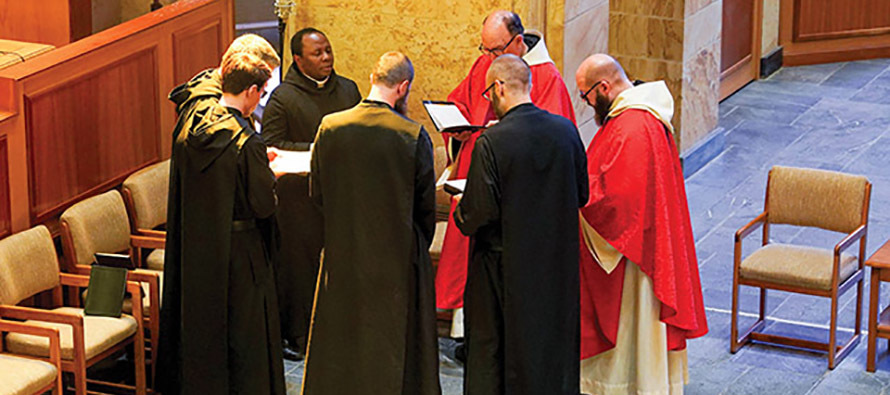
Monks chant at St. Bernard Abbey, two wearing the red vestments of priests (alb, stole, and chasuble) while the others wear the black monastic habit.
CLOTHING MATTERS. Whether we are playing Frisbee in the park or attending a business meeting, the clothes we wear say something about who we are and what we are doing. And that is not a new phenomenon. Throughout history people have used clothes to manifest who they are and what they are about. From Egyptian pharaohs and Roman senators to firefighters and Catholic priests—clothing has long been used to express mission and identity.
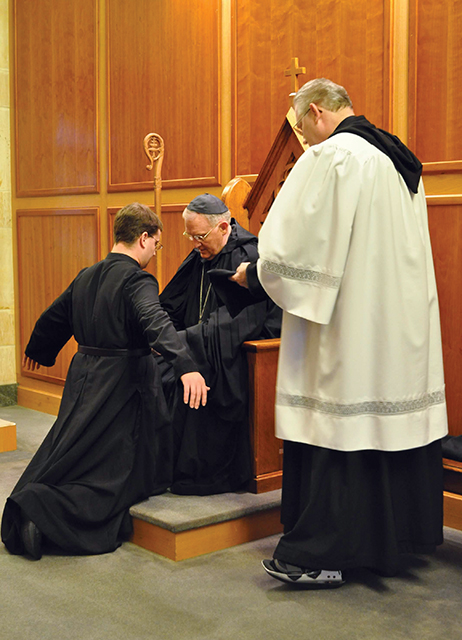
Monks are no exception. Although our robes may look mysterious and perhaps a little outdated, the religious habit we wear has significance. The black habit that we Benedictine monks wear is a sign of our consecration to God in the monastery. And it serves as a sign to the world—and to ourselves—of what we are supposed to be about—the things of God.
In fact, the English word habit (which we use to refer to our daily religious garments) comes from the Latin word habitus, which connotes a condition or state of life as well as attire. In other words, the habit we wear is a reminder of our way of life, a life consecrated to God through prayer and work with our brother monks in the monastery.
The habit has a long history. Beginning in the fourth century, a change of clothing was the defining part of the ceremony of monastic profession. (Profession is when a person takes vows promising to live in a religious community.) Long before spoken vows or written contracts were developed, receiving the monastic habit from the hands of the abbot (the superior of the community of monks) indicated that a man had become a monk. The monk’s habit, which the man put on for the first time, now indicated who he was and what he was about. The monastic habit became an important tool in reminding the man himself and others that he was now a monk and that his life now had a singular purpose: seeking God.
The custom of presenting a newcomer to the monastery with the monastic habit still happens today. Even now, some 1,500 years after the death of Saint Benedict, we Benedictine monks still see the habit as an important sign of our way of life. In my monastery, St. Bernard Abbey in Cullman, Alabama, the habit is given slowly, piece by piece, to the man as he progresses into the community.
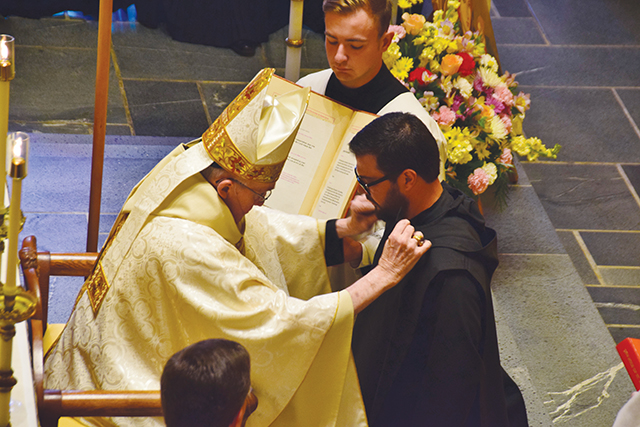
The abbot of the monastery places the hood, or capuche, around the shoulders of Brother Pachomius Alvarado, O.S.B. during his profession of temporary vows. The hood is the part of the habit that signifies, at St. Bernard Abbey, that a monk is a professed (vowed) member of the community.
Tunic and belt
When he first arrives at the monastery with the intent to join the community, a man receives the tunic and belt. These fundamental pieces of the habit signify that the newcomer wishes to learn and live the monastic manner of life.
Scapular
Later, when the man is admitted to the novitiate (a time of intense monastic living and a sort of year-long monastic boot camp), the abbot gives the novice the scapular, a long apron-like garment that hangs over the shoulders and is worn over the tunic and belt. This scapular, used originally as an apron for work, signifies the cross of Christ, which the novice freely accepts. “For my yoke is easy, and my burden is light.”
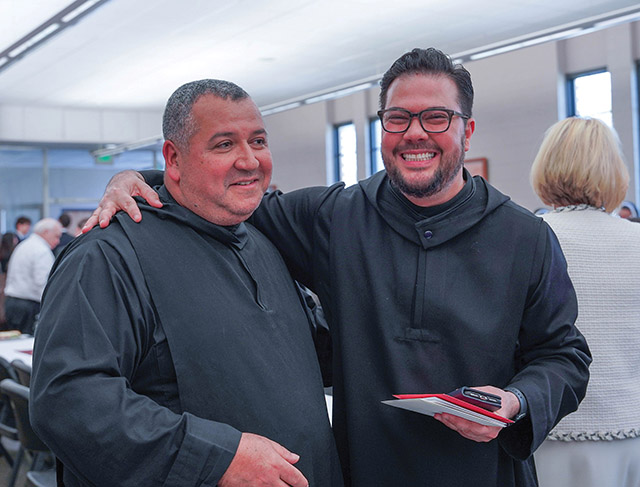
Hood
After having discerned the monastic way of life and having lived in the monastery for nearly two years, a novice can ask to make temporary vows in the monastery. With these vows, the novice commits himself to life in the community for three more years. Once again, this profession of vows is marked outwardly by yet another addition to the monastic habit: the hood. The monastic hood (or capuche) is placed on the head of the monk as a sign of dedication to God and as a “helmet of salvation” as he does “battle for the true King, Christ the Lord.” Thus, the professed monk is clothed with the monastic habit, a sign of consecration to God.
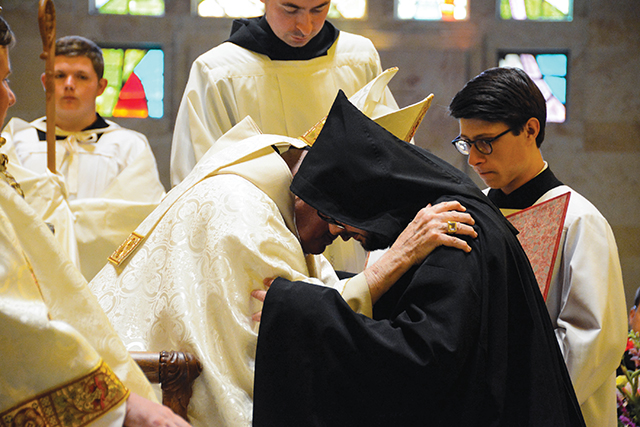
Cuculla
One last piece of the habit still remains to be given: the cuculla. The monk receives the cuculla when he makes solemn vows, also called final or perpetual vows, promising his entire life to God in the monastery. The cuculla is a long, pleated cloak that encompasses the monk. In addition to serving as a more formal habit for solemn liturgical celebrations, the cuculla signifies that the monks have accepted the monastic way of life and the Rule of St. Benedict.
Traditionally, the cuculla has 73 pleats that represent the 73 chapters of Saint Benedict’s Rule, which a monk freely accepts at the time of his solemn vows. Thus, when wearing the cuculla, he is clothed with the Holy Rule.
Deacon’s stole and dalmatic
After making solemn vows, some monks are ordained as deacons and priests. Once again, the abbot clothes them with the sacred vestments of their order. The deacon is vested in the stole and the dalmatic, a kind of tunic that is used for service at the altar and symbolizes the joy of serving the people of God and proclaiming the gospel.
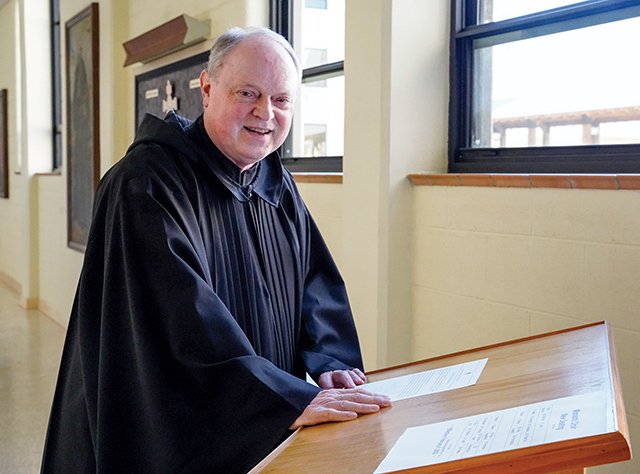
Priest’s stole and chasuble
Monastic life is life in a monastery. Those who belong to monastic religious orders (such as Benedictines or Trappists) live a communal religious life that is dedicated to praying the daily office and performing a ministry or type of work that fits into the emphasis on daily communal prayer and worship.
Both men’s and women’s religious institutes can be monastic. Monastic women typically call themselves “sisters.” Those who live cloistered lives, staying within the monastery walls, call themselves “nuns.”
The monks who are deacons are usually later ordained as priests. Then they are vested in clothing that priests wear at Mass: a stole (a long, flat type of scarf worn around the shoulders) and chasuble (a flowing poncho-like garment), which covers all the other sacred vestments and the religious habit that the monk wears beneath. The chasuble, covering all else, signifies love—the charity of God, which is the greatest of all the virtues; it covers the whole world.
Each piece of clothing that the abbot places on a monk signifies the life to which he has been called. It also reminds him of his responsibility. Just as the grace of God covers us, so too the monastic—and for some, priestly—clothing that is laid upon us symbolizes the gifts God heaps upon us, layer after layer.
In the end the clothing that monks or others in consecrated life wear is meant to remind them that the goal of their lives is always to further the kingdom of God. God is their source and their aim. It is in the joy of gospel living that they can cry out, “I will rejoice heartily in the Lord … For he has clothed me with garments of salvation, and wrapped me in a robe of justice” (Isaiah 61:10).
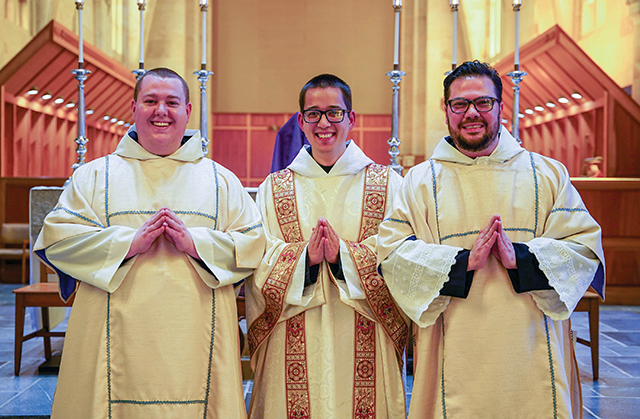
Related article: VocationNetwork.org, “17 questions about church vocations.”
Tags
- benedictine monks
- st bernard abbey
- scapular
- monastic habit
- tunic and belt
- hood
- cuculla
- deacon’s stole and dalmatic
- priest’s stole and chasuble
- robes
- sacred vestments
Related
- Taking a chance on God: Profile of Father David Gutierrez, C.M.F.
- About-face to the priesthood
- Moved by the power of the Eucharist: Profile of Father Duy Henry Bui Nguyen, S.C.J.
- No regrets: A grateful priest takes stock
- We’re different—in a good way: Profile of Father Roberto Mejia, O.Carm.
- Man with a mission
- Ministering to migrants in a carport cathedral
- Connections make the man: Profile of Father Kevin Zubel, C.Ss.R.
- A priest (who’s been there) responds to the pain of addiction
- In search of healing, one story at a time Read More
Most Viewed
- Find your spirituality type quiz
- Questions and answers about religious vocations
- Celibacy quiz: Could I be a nun? Could I be a brother? Could I be a priest?
- Resources for older discerners or those with physical and developmental differences
- About Vocation Network and VISION Guide


